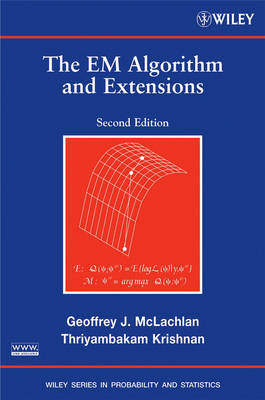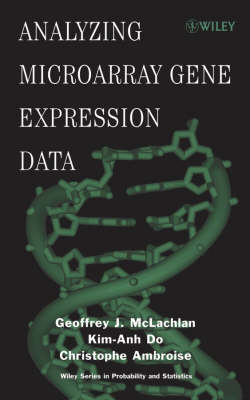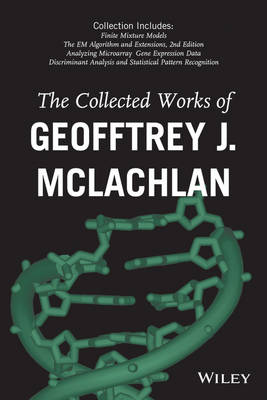Wiley Series in Probability and Statistics
4 primary works • 5 total works
Book 299
This is an up-to-date, comprehensive account of major issues in finite mixture modeling. This volume provides an up-to-date account of the theory and applications of modeling via finite mixture distributions. With an emphasis on the applications of mixture models in both mainstream analysis and other areas such as unsupervised pattern recognition, speech recognition, and medical imaging, the book describes the formulations of the finite mixture approach, details its methodology, discusses aspects of its implementation, and illustrates its application in many common statistical contexts. Major issues discussed in this book include identifiability problems, actual fitting of finite mixtures through use of the EM algorithm, properties of the maximum likelihood estimators so obtained, assessment of the number of components to be used in the mixture, and the applicability of asymptotic theory in providing a basis for the solutions to some of these problems. The author also considers how the EM algorithm can be scaled to handle the fitting of mixture models to very large databases, as in data mining applications.
This comprehensive, practical guide: provides more than 800 references - 40 per cent published since 1995; includes an appendix listing available mixture software; links statistical literature with machine learning and pattern recognition literature; and contains more than 100 helpful graphs, charts, and tables. "Finite Mixture Models" is an important resource for both applied and theoretical statisticians as well as for researchers in the many areas in which finite mixture models can be used to analyze data.
This comprehensive, practical guide: provides more than 800 references - 40 per cent published since 1995; includes an appendix listing available mixture software; links statistical literature with machine learning and pattern recognition literature; and contains more than 100 helpful graphs, charts, and tables. "Finite Mixture Models" is an important resource for both applied and theoretical statisticians as well as for researchers in the many areas in which finite mixture models can be used to analyze data.
Book 382
The EM Algorithm and Extensions 2e
by Geoffrey J McLachlan and Thriyambakam Krishnan
Published 15 November 1996
The only single-source--now completely updated and revised--to offer a unified treatment of the theory, methodology, and applications of the EM algorithm Complete with updates that capture developments from the past decade, The EM Algorithm and Extensions, Second Edition successfully provides a basic understanding of the EM algorithm by describing its inception, implementation, and applicability in numerous statistical contexts. In conjunction with the fundamentals of the topic, the authors discuss convergence issues and computation of standard errors, and, in addition, unveil many parallels and connections between the EM algorithm and Markov chain Monte Carlo algorithms. Thorough discussions on the complexities and drawbacks that arise from the basic EM algorithm, such as slow convergence and lack of an in-built procedure to compute the covariance matrix of parameter estimates, are also presented.
While the general philosophy of the First Edition has been maintained, this timely new edition has been updated, revised, and expanded to include:* New chapters on Monte Carlo versions of the EM algorithm and generalizations of the EM algorithm* New results on convergence, including convergence of the EM algorithm in constrained parameter spaces* Expanded discussion of standard error computation methods, such as methods for categorical data and methods based on numerical differentiation* Coverage of the interval EM, which locates all stationary points in a designated region of the parameter space* Exploration of the EM algorithm's relationship with the Gibbs sampler and other Markov chain Monte Carlo methods* Plentiful pedagogical elements-chapter introductions, lists of examples, author and subject indices, computer-drawn graphics, and a related Web site The EM Algorithm and Extensions, Second Edition serves as an excellent text for graduate-level statistics students and is also a comprehensive resource for theoreticians, practitioners, and researchers in the social and physical sciences who would like to extend their knowledge of the EM algorithm.
While the general philosophy of the First Edition has been maintained, this timely new edition has been updated, revised, and expanded to include:* New chapters on Monte Carlo versions of the EM algorithm and generalizations of the EM algorithm* New results on convergence, including convergence of the EM algorithm in constrained parameter spaces* Expanded discussion of standard error computation methods, such as methods for categorical data and methods based on numerical differentiation* Coverage of the interval EM, which locates all stationary points in a designated region of the parameter space* Exploration of the EM algorithm's relationship with the Gibbs sampler and other Markov chain Monte Carlo methods* Plentiful pedagogical elements-chapter introductions, lists of examples, author and subject indices, computer-drawn graphics, and a related Web site The EM Algorithm and Extensions, Second Edition serves as an excellent text for graduate-level statistics students and is also a comprehensive resource for theoreticians, practitioners, and researchers in the social and physical sciences who would like to extend their knowledge of the EM algorithm.
Book 422
Analyzing Microarray Gene Expression Data
by Geoffrey J McLachlan, Kim-Anh Do, and Christophe Ambroise
Published 24 August 2004
A multi-discipline, hands-on guide to microarray analysis of biological processes Analyzing Microarray Gene Expression Data provides a comprehensive review of available methodologies for the analysis of data derived from the latest DNA microarray technologies. Designed for biostatisticians entering the field of microarray analysis as well as biologists seeking to more effectively analyze their own experimental data, the text features a unique interdisciplinary approach and a combined academic and practical perspective that offers readers the most complete and applied coverage of the subject matter to date.
Following a basic overview of the biological and technical principles behind microarray experimentation, the text provides a look at some of the most effective tools and procedures for achieving optimum reliability and reproducibility of research results, including:* An in-depth account of the detection of genes that are differentially expressed across a number of classes of tissues* Extensive coverage of both cluster analysis and discriminant analysis of microarray data and the growing applications of both methodologies* A model-based approach to cluster analysis, with emphasis on the use of the EMMIX-GENE procedure for the clustering of tissue samples* The latest data cleaning and normalization procedures* The uses of microarray expression data for providing important prognostic information on the outcome of disease
Following a basic overview of the biological and technical principles behind microarray experimentation, the text provides a look at some of the most effective tools and procedures for achieving optimum reliability and reproducibility of research results, including:* An in-depth account of the detection of genes that are differentially expressed across a number of classes of tissues* Extensive coverage of both cluster analysis and discriminant analysis of microarray data and the growing applications of both methodologies* A model-based approach to cluster analysis, with emphasis on the use of the EMMIX-GENE procedure for the clustering of tissue samples* The latest data cleaning and normalization procedures* The uses of microarray expression data for providing important prognostic information on the outcome of disease
Book 583
Discriminant Analysis and Statistical Pattern Recognition
by Geoffrey J McLachlan
Published 24 August 2004
Provides a systematic account of the subject area, concentrating on the most recent advances in the field. While the focus is on practical considerations, both theoretical and practical issues are explored. Among the advances covered are: regularized discriminant analysis and bootstrap-based assessment of the performance of a sample-based discriminant rule and extensions of discriminant analysis motivated by problems in statistical image analysis. Includes over 1,200 references in the bibliography.
This collection includes: Finite Mixture Models By: McLachlan ISBN: 9780471006268 Describes the formulations of the finite mixture approach, details its methodology, discusses aspects of its implementation, and illustrates its application in many common statistical contexts. The EM Algorithm and Extensions, 2nd Edition By: McLachlan ISBN: 9780471201700 The EM Algorithm and Extensions, Second Edition successfully provides a basic understanding of the EM algorithm by describing its inception, implementation, and applicability in numerous statistical contexts. Analyzing Microarray Gene Expression Data By: McLachlan ISBN: 9780471226161 Following a basic overview of the biological and technical principles behind microarray experimentation, the text provides a look at some of the most effective tools and procedures for achieving optimum reliability and reproducibility of research results. Discriminant Analysis and Statistical Pattern Recognition By: McLachlan ISBN: 9780471691150 This book provides a modern, comprehensive, and systematic account of discriminant analysis and statistical pattern recognition.




